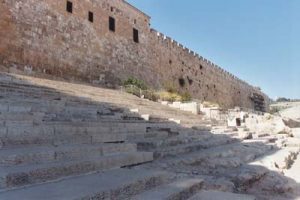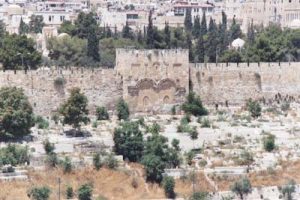by Pastor Ed Visser
When the day of Pentecost came, they were all together in one place. Suddenly a sound like the blowing of a violent wind came from heaven and filled the whole House where they were sitting.… All of them were filled with the Holy Spirit and began to speak in other tongues as the Spirit enabled them.…
Then Peter stood up with the Eleven, raised his voice and addressed the crowd….”
Acts 2:1-4,14
 One of my favorite places to visit while in Israel was the southern stairs of the Temple. Not only did it offer shade at the right time of the day, of great importance under the summer sun, but it is also a very “authentic” place. There are not many places in Israel where you can say for certain, “I stood/walked where Jesus did.” — but this is one of them. Many of the original steps leading up to the Temple remain, including the threshold in front of the main Temple entry gate, across which Jesus must have made a number of trips. This was also one of the best locations in Jerusalem for a teacher to speak to a group, something Jesus likely did as well.
One of my favorite places to visit while in Israel was the southern stairs of the Temple. Not only did it offer shade at the right time of the day, of great importance under the summer sun, but it is also a very “authentic” place. There are not many places in Israel where you can say for certain, “I stood/walked where Jesus did.” — but this is one of them. Many of the original steps leading up to the Temple remain, including the threshold in front of the main Temple entry gate, across which Jesus must have made a number of trips. This was also one of the best locations in Jerusalem for a teacher to speak to a group, something Jesus likely did as well.
But the southern stairs have a special meaning for the Christian church for another reason: this is the most likely location for at least some of the events of the day we know as Pentecost. That is actually the Greek term for the Jewish feast known as Shavuot or the Feast of Weeks. This harvest festival, held 50 days after the feast of first fruits, also celebrated God’s giving of the Torah on Mt Sinai. At nine in the morning — the time Peter identifies for us — every good Jew (Jesus’ disciples included) would have been at the Temple for the morning sacrifices related to this feast.
 For some reason, over the years, the Christian church has often associated Pentecost with the Upper Room, but there is no indication of this in Acts 2. In fact, all the clues point to the Temple: 1) ‘House’ in Jerusalem (v.2) was always the Temple; 2) every good Jew would be there for the feast at 9AM (15); 3) it would be the only place where you’d have so many foreign (diaspora) Jews (5-11); 4) the southern stairs was a logical place for Peter to preach to such a large audience, and 5) the only area in Jerusalem with enough mikveh’s (ceremonial baths) — over 140! — to baptize 3000 people (41).
For some reason, over the years, the Christian church has often associated Pentecost with the Upper Room, but there is no indication of this in Acts 2. In fact, all the clues point to the Temple: 1) ‘House’ in Jerusalem (v.2) was always the Temple; 2) every good Jew would be there for the feast at 9AM (15); 3) it would be the only place where you’d have so many foreign (diaspora) Jews (5-11); 4) the southern stairs was a logical place for Peter to preach to such a large audience, and 5) the only area in Jerusalem with enough mikveh’s (ceremonial baths) — over 140! — to baptize 3000 people (41).
For God, often represented by wind and fire in the Old Testament, to fill and then leave the Temple, was a picture of God changing his address. No longer does he live in the Temple in Jerusalem, but in his followers, those Paul described as “the Temple of the Holy Spirit.”

